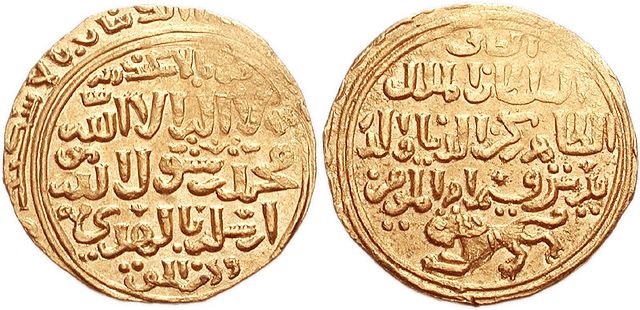The gold dinar is an Islamic medieval gold coin first issued in AH 77 (696–697 CE) by Caliph Abd al-Malik ibn Marwan. The weight of the dinar is 1 mithqal.
Umayyad gold dinar minted at Damascus, Syria in AH 77 (697 CE) having a weight of 4.24 grams
Gold Dinar of the 20th Abbasid Caliph Ar-Radi bi'llah (934–940 CE)
Dinar issued during the reign of the Fatimid emir Al-Mu'izz li-Din Allah in Mansouria, Tunisia in 344 AH (955 CE)
Dinar Mamluq sultan Baybars (658–676 AH (1260–1277 CE)
Abd al-Malik ibn Marwan ibn al-Hakam was the fifth Umayyad caliph, ruling from April 685 until his death in October 705. A member of the first generation of born Muslims, his early life in Medina was occupied with pious pursuits. He held administrative and military posts under Caliph Mu'awiya I, founder of the Umayyad Caliphate, and his own father, Caliph Marwan I. By the time of Abd al-Malik's accession, Umayyad authority had collapsed across the Caliphate as a result of the Second Fitna and had been reconstituted in Syria and Egypt during his father's reign.
Gold dinar minted by the Umayyads in 695, which likely depicts Abd al-Malik.
The Ka'aba in Mecca (pictured in 1917) was the headquarters of Ibn al-Zubayr where he was besieged and defeated by Abd al-Malik's forces led by al-Hajjaj ibn Yusuf in 692
In 698 Abd al-Malik's forces led by Hassan ibn al-Nu'man destroyed Carthage (ruins pictured in 2013), which signaled "the final, irretrievable end" of Byzantine power in North Africa.
The nearby town of Tunis (pictured in 2017) was subsequently founded on the caliph's orders and equipped with a naval arsenal.








